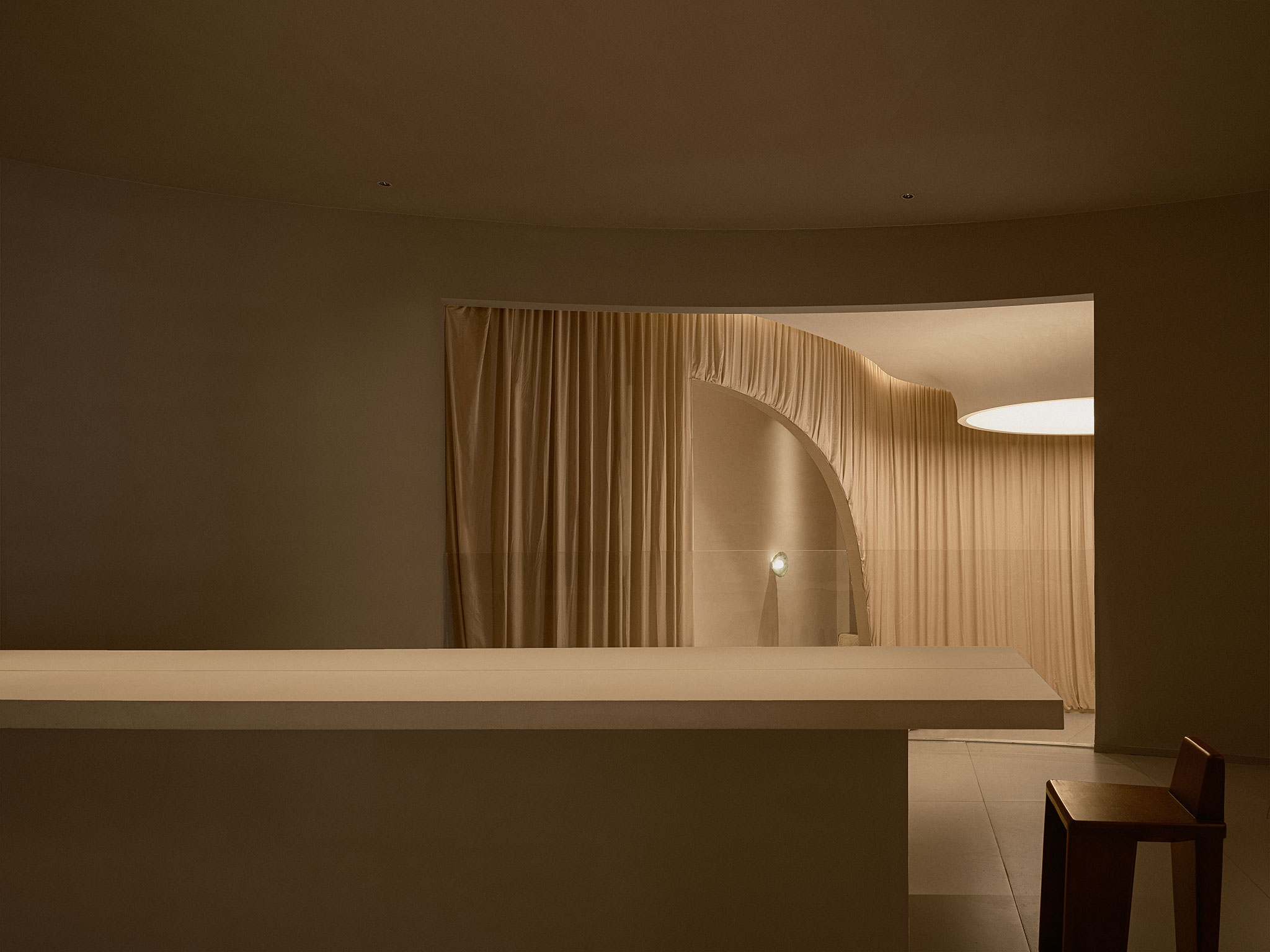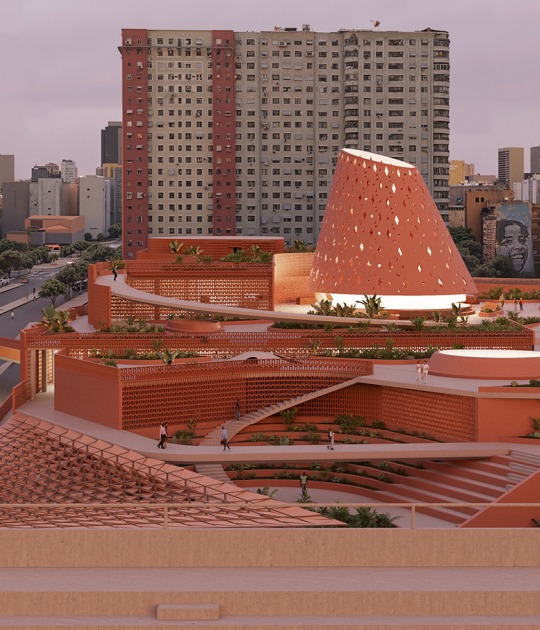The element that presides over the central space of the project is a raised platform surrounded by curved walls and curtains arranged in a waterfall that seek to create a fluid effect and help perceive emotions when immersed in memories of nature. Going up the stairs, you access the curved interior and reach a large area for drinking tea. The enveloping geometry of this space seeks to create a place where customers can feel a sense of familiarity and warmth and where the soft aroma of tea intertwines with the subtle changes of color, gradually occupying their hearts.
 Ye Xiao Xiao, Tea space by Aurora Design. Photograph by Na Xin, INSPACE.
Ye Xiao Xiao, Tea space by Aurora Design. Photograph by Na Xin, INSPACE.
Project description by Aurora Design
The Baipu, an ancient extinct people from Yunnan province of Southwestern China, were the earliest group to start tea-drinking and engage in tea trade. Tea farming and culture thrived in Yunnan Province thousands year ago, therefore, Yunnan Province was considered as the birthplace of tea culture. The stories of Tea Horse Road and Waste Water Bowl(Jian Shui) have been passed down through the years amist the hawking and the sounds of rolling wheels, which have been instilled new vigor and vitality to the spirit of Tea Culture.
As one of the representatives of the “new tea brands” , AURORA DESIGN chooses the “emotional design” as the main approach to depict the space by projecting different types of “emotions” in a tangible way. These emotions converge into the taste of tea, emerging customers into fragrant experiences.
By capturing the emotions from tea horse road in the culture of South Yunnan, the designer has created a tranquil space which enable customers to immerse themselves in a sense of peace by sitting beside the floor-to-ceiling windows and leisurely strolling along the winding paths within the space. Like a traveler through time, they can glimpse fragments of history. The space is divided by circles of varying sizes, creating a fluid and interwoven path that guides people through different emotional experiences.

Ye Xiao Xiao, Tea space by Aurora Design. Photograph by Na Xin, INSPACE.
The main material used for the entrance bar counter is combined with the emotion from Tea Horse Road. The emotional experience has been deepened within the space by using the primitive“earth tone”, making it a more textured space with a sense of nature. Serenity and simplicity serves as the emotional keynotes of the space, where the emotion changing with the curving path and different emotional expressions unfold within the shared memory.
The scattered leaves recalled one of your memories of the fragments of history. The rustling of the fallen leaves echoes like the whispers of history. When customers step into the space wrapped with white curtains, a seed of “emotion” was planted in the pulsating heart. It sprouts, and grows up in the aroma of tea. Elegance and tranquility solidify into spatial memories beyond the boundaries of history.The interplay between curtains and wood alcoves, softness and hardness, mirrors the tension between reality and illusion, striking a harmonious balance within the entire space.
A raised platform dominates the centre of the room, surrounded by curved walls that create white spaces. Warm fabric curtains cascade down like a waterfall, creating a flowing effect. One can taste freshness and savor the interwining of emotions and nature when they immerse themselves in the memories of nature. This creates a richer experiential journey where life and emotions intersect, offering a more diverse scene experience. Ascending along the staircase, one enters the curved interior, arriving at a spacious tea-drinking area. The entire space presents an embracing posture, where customers can deeply feel a sense of familiarity and warmth as they immerse themselves within it. Simple and elegant indoor plants and well-placed decorative arrangements allow the views to be fully enjoyed. The fusion of clouds, scenery, mountains, water, and the human emotional experience reaches its pinnacle in this setting.

Ye Xiao Xiao, Tea space by Aurora Design. Photograph by Na Xin, INSPACE.
The whole space was softly enveloped by curtains, the main tone of the design, making the whole space more comfortable. “Fabric”, serving as the medium of communication, gets in touch with the intimate territory of the soul by its soft texture and form. We desperately need a quite corner for soul projection and self-fulfillment when we are facing ubiquitous emotions. Here, visitors can totally free them from the noisy world, experiencing love and serenity in the gentle and tranquil space. That’s the purpose of the designer.
The principle of decorative arrangements also follow the organic forms that have been emotionally deconstructed by the designer, which is achieved through a variety of different plant types such as bonsai and single cluster of plants. The technique of active white space design is employed to enhance the “tranquil” atmosphere. Organic forms, such as the solid wood furniture and flowing patterns on the stone, are extracted from the natural landscapes, completing the “emotional purpose” in the design.
The warm tone dominates the space with colors ranging from pure white, beige and dark brown: the shifting color impacts our emotional journey, guiding us from the state of tranquility to deep contemplation. Thoughts slowly drift within each "circle," descending along delicate veils and lingering along the edges of the curves. The gentle scent of tea intertwines with the subtle changes in color, gradually occupying our heart. The designer is aiming to convey and express the state of mind through colors, with each color corresponding to a specific emotion.

Ye Xiao Xiao, Tea space by Aurora Design. Photograph by Na Xin, INSPACE.
Based on the local culture, Aurora Design adopts organic forms to shape the layout and build an “emotional islands” in the context of modern society through an intentional expression of emotions, allowing different emotions to land and rest in peace.
The abstract emotions can be felt and experienced within the space due to the organic forms and the soft mediums. The design puts focus on the connection between nature and humanity, as well as the interplay between emotion and inner thoughts, therefore, the physical surroundings and emotions coexist in a perfect harmony through visual cues, emotional resonance and imaginative exploration.
Every single plant and every sip of tea comes from “emotion”. In this tranquil and warm space, the design team wish the visitors can focus on their inner heart and emotions instead of physical feelings, therefore, reconstructing the worldview when confronted with the complexities of modern life.
















































